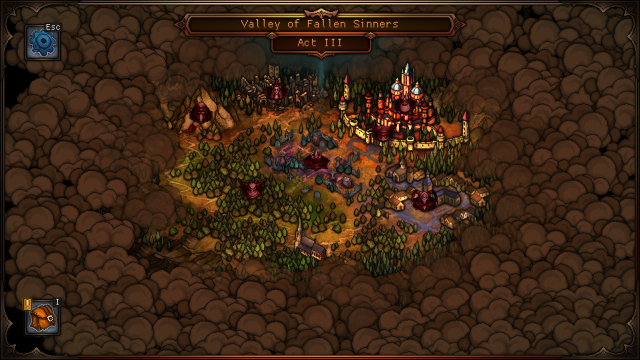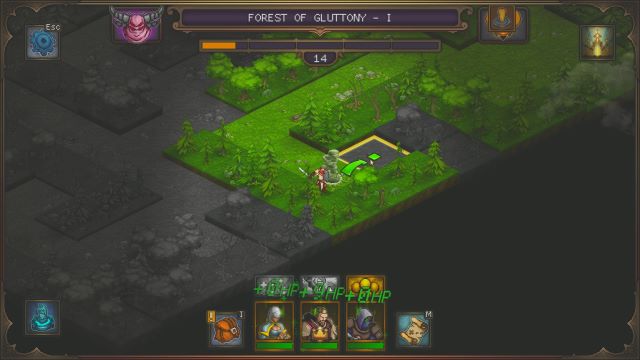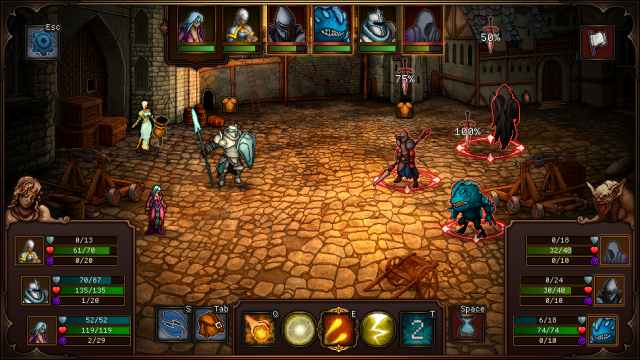Sin Slayers is a JRPG. But it’s not just any JRPG, oh no. Sin Slayers, instead, opts to mesh this classic genre with another, the roguelike. You might be wondering how that works — how can you build a party of heroes if they’re just going to end up dying?
Well, the good news is that they don’t die. There’s a reason for it, though.
The game opens with your party of classic D&D characters finding themselves fighting off hordes of baddies and, well, not performing very well.
Cornered, they take refuge in a church at the behest of an old, blind sage. They breathe a moment, hoping that at the very least, they are now safe.
Whoops…
Alas, it turns out that they can’t leave the church or the Valley of Fallen Sinners in which it resides, at least not until they’ve defeated the embodiments of the deadly sins of Lust, Wrath, Gluttony, Sloth, Envy, Pride, and Greed.
These beings are known as Sinlords and must be destroyed to release the seals and allow our heroes to escape. When the game tells you that you can’t leave, that includes even death.
Each Sinlord has a corresponding seal, and these seals don’t allow your party members to truly die. From a gameplay sense, this makes things much easier as it allows you to continue building your preferred party members, but it certainly sucks for the party members themselves who will have to keep trying no matter what.

What, then, are the roguelike elements?
Well, each of the Sinlords has taken up residence in a different area of the game, and each of these areas features a little bit of procedural generation in its layout, the various events you can happen across, and the enemies you face.
You select these areas from a world map of sorts, then navigate around the grid-based maps by clicking on the tile you’d like to move to. Until you walk onto a tile, you’ve no idea what’s there, which means you could be walking straight into a fight, or you could stumble upon a healing fountain.
While this is an initially entertaining idea, it becomes repetitive quite quickly, which can make the later areas quite annoying. Especially as there is a very limited pool of different events to find, and they’re very rarely worth taking part in.
Sin To Win
Taking part in events will often generate sin. If you sin too much, then the enemies in the area will become stronger. However, you can offset this by using special shrines or simply ignoring the events. Though that often means leaving a rotting corpse on the side of the road instead of burying it to avoid sinning, of course.
Don’t worry, it doesn’t always make sense.

Despite the strange, often perplexing meta-narrative weaving throughout the game, the combat is probably the main star of the show here — or at least it should be.
Everything here is relatively standard turn-based stuff: each combatant takes a turn to perform a single action, and as you progress through each fight, you build up your Rage, which is essentially MP that you spend on more powerful abilities.
However, the main thing to pay attention to is, of course, your party composition, which you can change as you unlock new characters.
Most characters can be unlocked by defeating a Sinlord, but there is a drawback. Characters join you at Level 1, although the max level is five. So while it doesn’t take long to train and level them, it’s never really worth doing so. I found myself using an entirely overpowered team very early on, and only swapped out a party member once when I finally acquired a magical class.
For the most part, there’s never really nay reason to switch to new party members once you’ve leveled the initial characters.
In fact, difficulty is a real issue here. The areas you go through are meant to be more and more challenging as you progress, but the enemies you fight are often Level 1 or Level 2 no matter which stage they are in. This means you trounce them right off the bat once you’ve leveled up your party.
I’d often find myself staring at my defeated foes within a turn or two of starting a battle. That’s not really what you want from a roguelike such as this. In fact, there’s an achievement for having your entire party killed five times. That’s one of two that I didn’t get in my seven hours with the game.
It’s just not challenging enough.

Pros
- Some good ideas
- It’s short?
Cons
- Boring combat
- Uninteresting exploration
- Bad story
The lack of challenge in Sin Slayers means you won’t want to replay it, which means it kind of fails as a roguelike. That also means you’re only left with the JRPG side of things as they attempt to lure you in with promises of complex battle mechanics and a gripping story — neither of which exist here.
Consequently, what you have with Sin Slayers is a game that doesn’t do anything very well. Which means it’s probably not worth playing.
[Note: A copy of Sin Slayers was provided by Black Tower Entertainment for the purpose of this review]










Published: Aug 29, 2019 3:13 PM UTC